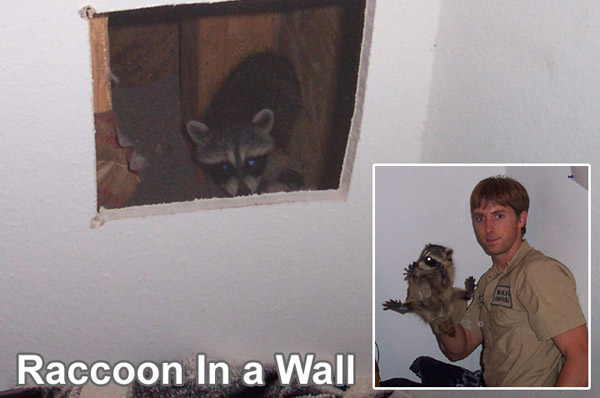
Raccoons are known to live in human dwellings and mostly dwell in torn walls and the attic. These places provide a warm and safe place for them to live and offer close proximity to food. They feed on garbage food and any human-influenced food. Raccoons can cause a lot of damage and become a nuisance to humans. Once in the house, they will tear up pipes, walls and rip open ducts. They also scare your pets – sometimes they will even kill cats and other small pets - and tip over garbage cans, leaving you a nice smelly mess to clean up.
They can cause diseases to humans through their droppings and the parasites they carry. Rabies is one of the most common diseases a raccoon carries. Although they are cute little bandit looking creatures, they are not docile and can become extremely dangerous. They have very sharp claws and teeth and are not afraid to attack if they feel threatened in any way.
Causes for Raccoons in the Wall
Raccoons are very intelligent and, just like most mothers, the mother raccoon will look for the safest place for her babies; which is usually your attic. The attic provides protection from the elements and other predators.
The little bandits are experts at getting into secured areas. They are very strong and have been known to rip off boards and other material to get inside attics and homes. Once inside, they will cause a lot of irritating noises as they scurry around looking for food sources while also damaging your home.
The Raccoon Menu: Pretty Much Everything in and Around Your Home. Raccoons aren’t picky when it comes to food; if it’s anywhere available, they’ll get to it. They really are little bandits and can get into places that you thought were secured. They will eat just about anything they can get their little hands on including fish in a pond, dog and cat food, garbage from your trash can, bird feed and so much more. They are experts at finding ways into your home and have been known to use pet doors to go inside and get food right out of your home.
So, how do I get Rid of My Raccoon Problem?
This is a problem as raccoons are not easily gotten rid of without the expert help of professionals. There are traps, of course, that you can set up to help trap the critters; however, you will need to research this method carefully as you are likely to inadvertently capture a pet – yours or your neighbors.
Usually when there is a raccoon in the attic, it is a mother raccoon with babies. Just trapping the mother will not solve your problem as there are still babies to contend with. Also, trapping is not legal in all states, so before you go gung ho looking for traps, make sure that your state allows trapping them. If it is legal to trap in your state, then you will need to relocate the critters several miles from home, otherwise they will likely find their way right back to your attic.
Trapping the babies first to lure the mother is probably one of the best ways. Babies will need to be captured by hand, using protective gloves and a mask to prevent inhaling pathogens that can make you very sick. Once the babies are trapped, you can use them to lure the mother to them.
Traps should be located where other pets and non-targeted animals will not be travelling. This is another reason that a specialist should be called out to handle the raccoon problem. Say, for instance, you set a trap on the roof where you noticed the raccoon has made a doorway into your attic. You may catch the raccoon in the trap, but they have sharp claws on those little hands that can pick apart and destroy the shingles on your roof. You will need to put some extra protection under the cage to help prevent more damage.
There are so many variations in capturing and removing raccoons that can go wrong; catching the wrong animals, getting bit and/or scratched, not retrieving the babies and so on. Because these animals are highly intelligent and skilled, it is best to seek professional help for removal.
Let’s Talk Prevention:
One of the best things you can do to help keep raccoons away is to take preventative measures. The most important, of course, is to remove their food source and abilities to get to it.
Make sure that your attic is secured without any holes or easy access for the raccoons to enter if you really want to know the best step for how to get rid of raccoons in the wall. Do not leave pet food bowls out and available. If you have a pet door, it might be wise to keep it sealed for a while until the raccoons decide it’s not worth the effort and stops trying to get into your home. Tightly secure your garbage cans so that they cannot get into them or tip them over to get to the goodies inside. Make sure your yard is clean and don’t leave food or bird feeders outside since it will attract the raccoons.
Go back to the
How To Get Rid of Raccoons home page.